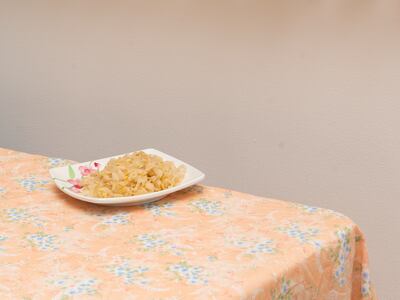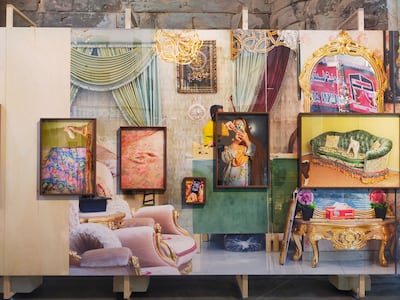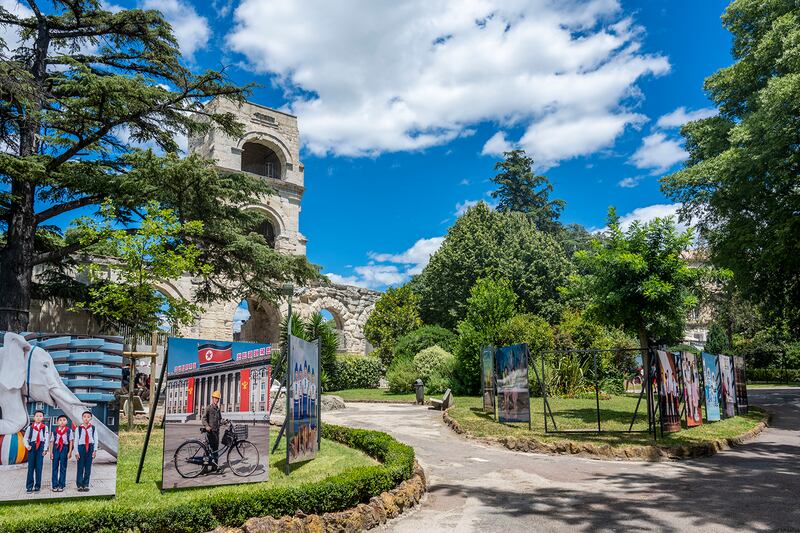To make silky hummus you must first remove the chickpea skins – a ritualistic and time-consuming act of preparation.
This is a message conveyed in Emirati photographer Farah Al Qasimi's Chickpea Skins (2021), on view as part of Les Rencontres d’Arles, a photography festival taking place in Arles, France.

The event has taken over the Provencal city during the summer months every year since 1970. It plays an influential role in establishing an appreciation for photography – in 2019, it attracted 145,000 visitors – but owing to the pandemic, it was postponed last year. Now, it's back in full swing, having opened at the start of July. Presenting material that has never been publicly viewed before, Les Rencontres d’Arles gives exposure to new talents.
For this year, it has undergone a transformation in leadership and structure. New director Christoph Wiesner took the lead during the pandemic and proposed a fresh curatorial approach for the event's Louis Roederer Discovery Award, for which art institutions present the work of an up-and-coming talent, with the prize being an acquisition to the tune of €15,000 ($17,657).
Wiesner announced that each year a new curator will contribute to the exhibition, starting this year with French author and curator Sonia Voss. “When we stop, we think differently,” Wiesner says. “It’s a time to reset. Before, the award had a classical configuration of small, separate exhibitions, but this year it was important to bring emerging artists into the centre of the city.”
Al Qasimi’s exhibition, titled Imitation of Life, is on view as part of this segment of the festival, alongside nine other shortlisted photographers from far-reaching social and cultural contexts.
Though Al Qasimi currently lives in Brooklyn, New York, her work zooms in on daily life in the UAE, as well as aspects of identity along the intersections of gender, nationality and social class.
Al Qasimi’s installation comprises eight photographs varying in scale and orientation, which are part of an ongoing series. They hang against a backdrop that depicts a scene from a furniture store in Sharjah.

“Al Qasimi trusted me to offer my own re-reading when curating her works,” explains Voss. “For me, she’s engaging with the paradox between social and private spaces.”
Drawing from the codes of portraiture in the western painting practice, as well as documentary photography, Al Qasimi subverts fixed notions of how the image might be constructed and read. Her scenes feel both staged and as though they are revealing something intimate; they continue to unravel the more they are observed. She also regularly captures her realities as she encounters them, returning to her images later to organise them into projects and develop the conceptual framework.
Her subjects are lodged in the domestic realm, spaces populated with opulent interiors from kitsch cartoon characters to tiny floral prints. The traces of several (and conflicting) cultural elements are apparent, some characteristic of the Arabian Gulf, while others are remnants of British colonialism. The presence of hypermodernity, through the foregrounding of the iPhone and the invasion of high technology in the home space, is also palpable. It’s a heterogenic mix of visual elements that illuminate some of the more intimate spaces inhabited by the UAE’s upper-middle-class youths today.
Goat Farm Majlis (2021), meanwhile, reveals the humour that regularly underpins Al Qasimi’s practice, as unexpected intruders – two goats – escape the agricultural context and arrive in the living room. Together these images offer a glimpse into contradictions – between tradition and modernity, and inner and exterior worlds – that she might encounter behind closed doors.
“All the works were shot in private residences and some in the artist’s family home,” says Voss. “Our selection focuses upon women and how they inhabit these spaces. Hand Print (2021) is very sensual, revealing only the imprint of the human form upon fabric, while Self-Portrait in Bedroom (2021) plays with visibility in a more direct manner as the subject’s face is obscured by the iPhone that both blocks her features and releases her into the social realm.”

Imitation of Life also defies what Voss has identified as a trend among the other exhibitors. “Al Qasimi's images comprise bursts of colour and daring compositions, they are full and saturated. This works well in juxtaposition with the pieces by other artists that are black and white and more minimalistic,” she says.
“I was both disturbed and amazed by her proposition and its audacity. The questions she addresses are subtle and important ones that negotiate boundaries – the visibility and representation of female bodies, the position of women in the Arab world and the way that they interact in the social and intimate space of the home. It’s not directly political but very complex, it’s multilayered, revealing a clash of cultures and aesthetics.”
While in dialogue with the artists shortlisted for the Louis Roederer Discovery Award, Voss began to observe connections between them. “There were common uses of material, thematics and underlying concerns, such as displacement and exile. It was surprising how many threads I could find. I tried to build up the exhibition with these commonalities in mind while presenting each artist as independent and autonomous,” she says.
In addition to this sense of exile there is also exploration of the notion of home and nationhood, as evidenced in the works presented by Al Qasimi, as well as Marie Tomoanova's autobiographical story recounting a homecoming from New York to her farm in a Czech village, after a decade of absence.
Voss’s curation works in close connection to the exhibition space, the 15th-century Eglise des Freres Precheurs, a Gothic church. Filling the aisle is Eros and Thanatos Made a Child, a mixed-media, site-specific installation by Berlin artist Mariana Hahn. Her output includes various materials subjected to processes of transformation, such as fossilisation, and she pays homage to photography as a medium and a process.
What’s most striking and instantly understood upon entry to Les Rencontres d’Arles, when met with a large-scale hanging textile installation and mounds of white powder on the floor, is that photography, in its traditional sense, has been stretched beyond its normal limits. Such inclusions demonstrate Voss’s desire to push the boundaries of the practice and engage with photography in a less direct manner.
Les Rencontres Des Arles is on view until Sunday, September 26





